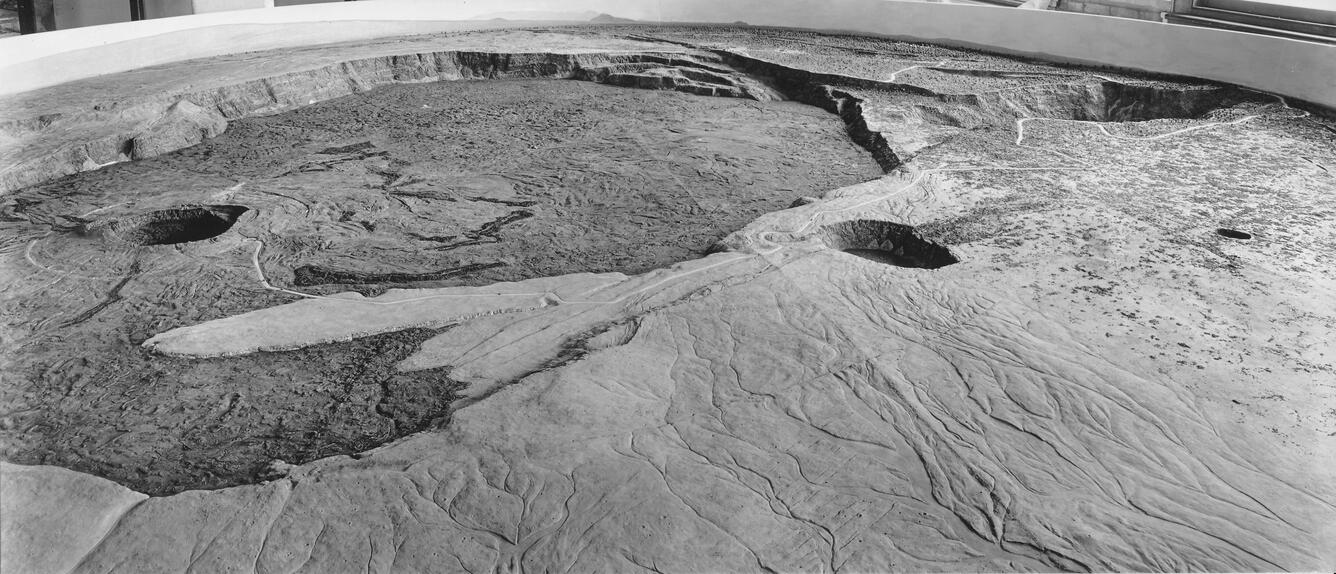Volcano Watch — Modeling Kīlauea Volcano a Century Ago
In today's age of aerial photography, satellites, and drones, bird's-eye views of geologic features are taken for granted. A century ago, such depictions posed enormous challenges.
At first glance, the images above appear to be aerial photographs of Kīlauea Volcano's summit caldera, but these photos were taken six years before the first airplane overflight. The images actually show a model of the volcano displayed at a Harvard University museum for many decades.
So, how was the model constructed? And who made it?
The story began in March 1913, when George Carroll Curtis, an artist, geologist, geographer, and expert in the production of relief models, traveled to the Island of Hawai‘i to make a careful survey of the caldera at the summit of Kīlauea. He established a network of survey flags and took photographs at each using a revolving panoramic camera that provided a complete view of the caldera. But progress constructing the model was slow, because Curtis lacked a high altitude perspective of Kīlauea's summit.
To solve this problem, Curtis encouraged J.F. Haworth, a wealthy businessman from Pittsburg, to go to Kīlauea and pursue his hobby of flying kites. But these were no ordinary kites.
Each box kite was over 11 feet (3.4 m) long and 9 feet (2.7 m) wide. Instead of string, Haworth used a motorized reel of piano wire to launch and tether the kites, which were capable of lifting a payload of about 100 lbs (45 kg). For the Kīlauea study, the payload was a camera positioned on a wire line several hundred feet (about 60 m) below the kite. A small device was sent up the piano wire to trip the camera shutter for each photograph.
When Haworth arrived at Kīlauea in 1915, he found that kite photography was no picnic on a volcano. High winds at the summit repeatedly dragged the photographer over sharp lava, leaving him bruised and battered. But he finally succeeded in taking a series of photos of Kīlauea Volcano's summit from various altitudes. These aerial photographs enormously speeded up the work of Curtis on his model.
In 1917, the relief map was finally installed in the Geological Section of the Harvard University Museum and opened for public viewing. The circular model was 14 feet (4.3 m) in diameter, and it was built with a scale of 125 feet to an inch (38 m to 25mm), so there was no vertical exaggeration.
At this scale, Curtis was able to depict minute details of the summit. The model shed light on many geologic features that had not been observed before, such as the elaborate drainage system on the south side of the caldera. Photographs of the model are useful even today to locate historic sites, including roads and other structures that are long gone.
This huge model remained at the Mineralogical and Geological Museum at Harvard University until the mid-1970s, when building renovations required that the exhibit be moved. Unfortunately, the size of the model made relocation impractical, so it was dismantled.
We have searched, without success, for the original summit photographs taken by Curtis and Haworth. Our hope is that they still exist somewhere, preserved in an archive or personal collection of photos. If so, we would love to see them. Images by these intrepid photographers from a century ago could shed new light on features that are the subject of current volcano research.
If you know of these images, or have other historical photographs of Hawaiian volcanoes, HVO would like to hear from you. Email us at askHVO@usgs.gov.
Volcano Activity Update
This past week, Kīlauea Volcano's summit lava lake level fluctuated with summit inflation and deflation and ranged about 32–37.5 m (105–123 ft) below the vent rim. On the East Rift Zone, the 61g flow remained active, with surface breakouts downslope of Pu‘u ‘Ō‘ō and lava entering the ocean near Kamokuna. The 61g flows do not pose an immediate threat to nearby communities.
Mauna Loa is not erupting. During the past week, small-magnitude earthquakes continued to occur beneath the summit caldera and upper Southwest Rift Zone, primarily at depths less than 5 km (3 mi). Small earthquakes were also scattered beneath the upper western and northern flanks of the volcano. GPS measurements continue to show deformation related to inflation of a magma reservoir beneath the summit and upper Southwest Rift Zone. No significant changes in volcanic gas emissions were measured.
Three earthquakes were reported felt on the Island of Hawai‘i during the past week. On October 3, at 4:25 a.m. HST, a magnitude-2.9 earthquake occurred 12 km (7 mi) southeast of Honoka‘a at 12 km (7 mi) depth. On September 30, 2017, at 10:33 a.m., a magnitude-3.5 earthquake occurred beneath Pāhala at 36 km (22 mi) depth, and at 5:50 p.m., a magnitude-3.0 earthquake occurred 12 km (7 mi) west of Kalaoa at 34 km (21 mi) depth.
Get Our News
These items are in the RSS feed format (Really Simple Syndication) based on categories such as topics, locations, and more. You can install and RSS reader browser extension, software, or use a third-party service to receive immediate news updates depending on the feed that you have added. If you click the feed links below, they may look strange because they are simply XML code. An RSS reader can easily read this code and push out a notification to you when something new is posted to our site.



